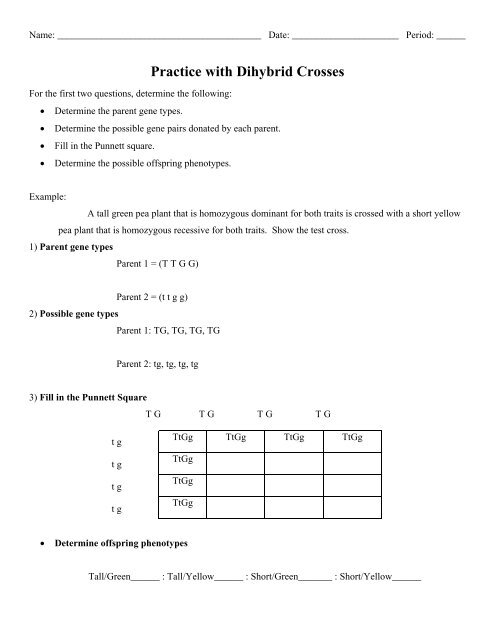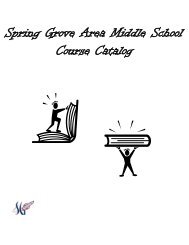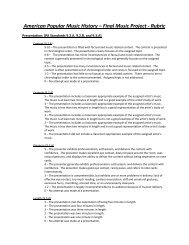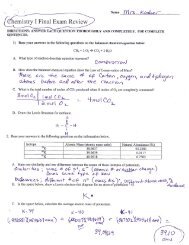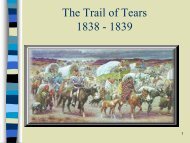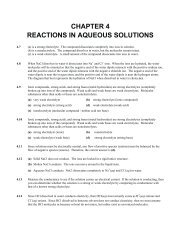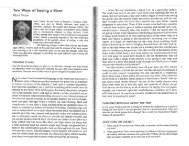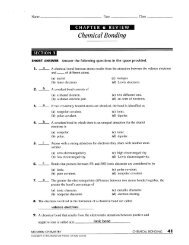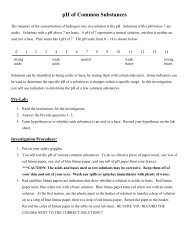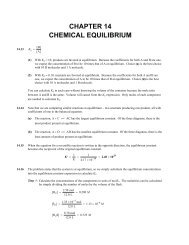Practice with Dihybrid Crosses
Practice with Dihybrid Crosses
Practice with Dihybrid Crosses
Create successful ePaper yourself
Turn your PDF publications into a flip-book with our unique Google optimized e-Paper software.
Name: __________________________________________ Date: ______________________ Period: ______<br />
<strong>Practice</strong> <strong>with</strong> <strong>Dihybrid</strong> <strong>Crosses</strong><br />
For the first two questions, determine the following:<br />
Determine the parent gene types.<br />
Determine the possible gene pairs donated by each parent.<br />
Fill in the Punnett square.<br />
Determine the possible offspring phenotypes.<br />
Example:<br />
A tall green pea plant that is homozygous dominant for both traits is crossed <strong>with</strong> a short yellow<br />
pea plant that is homozygous recessive for both traits. Show the test cross.<br />
1) Parent gene types<br />
Parent 1 = (T T G G)<br />
Parent 2 = (t t g g)<br />
2) Possible gene types<br />
Parent 1: TG, TG, TG, TG<br />
Parent 2: tg, tg, tg, tg<br />
3) Fill in the Punnett Square<br />
T G T G T G T G<br />
t g<br />
t g<br />
t g<br />
t g<br />
TtGg TtGg TtGg TtGg<br />
TtGg<br />
TtGg<br />
TtGg<br />
<br />
Determine offspring phenotypes<br />
Tall/Green______ : Tall/Yellow______ : Short/Green_______ : Short/Yellow______
1. A long neck yellow giraffe (T t Y y), mates <strong>with</strong> a short neck orange giraffe (t t y y).<br />
___________ X ___________<br />
Possible phenotypes<br />
Long/Yellow____ : Long Orange ____ : Short/Yellow ____ : Short/Orange____<br />
2. A fast red fox (F f R R), mates <strong>with</strong> a slow grey fox (f f r r).<br />
___________ X ___________
Possible phenotypes<br />
Fast/Red____ : Fast/Grey ____ : Slow/Red ____ : Slow/Grey ____<br />
3. A pea plant is heterozygous for both seed shape and seed color. S is the allele for the dominant,<br />
spherical shape characteristic; s is the allele for the recessive, dented shape characteristic. Y is the allele<br />
for the dominant, yellow color characteristic; y is the allele for the recessive, green color characteristic.<br />
What will be the distribution of these two alleles in this plant's gametes<br />
4. What genetic cross would give a phenotypic ratio of 9:3:3:1<br />
5. List the gametes of a plant of genotype SSYy.<br />
6. Which genotypes would you expect to find among the offspring of a SsYy x ssyy test cross<br />
7. What is the expected phenotypic ratio of the progeny of a SsYy x ssyy test cross
8. In a dihybrid cross, AaBb x AaBb, what fraction of the offspring will be homozygous for both recessive<br />
traits<br />
9. Following a SSYy x SsYy cross, what fraction of the offspring are predicted to have a genotype that is<br />
heterozygous for both characteristics
10. In a dihybrid cross, SsYy x SsYy, what fraction of the offspring will be homozygous for both traits<br />
11. About 70% of Americans perceive a bitter taste from the chemical phenylthiocarbamide (PTC). The<br />
ability to taste this chemical results from a dominant allele (T) and not being able to taste PTC is the<br />
result of having two recessive alleles (t). Albinism is a trait <strong>with</strong> normal pigment being dominant (A)<br />
and the lack of pigment being recessive (a). A normally pigmented woman who cannot taste PTC has a<br />
father who is an albino taster. She marries a homozygous, normally pigmented man who is a taster but<br />
who has a mother that does not taste PTC. What are the genotypes of the possible children
What percentage of the children will be albinos<br />
What percentage of the children will be non-tasters of PTC<br />
12. Wolves are sometimes observed to have black coats and blue eyes. Assume further that normal coat<br />
color (N) is dominant to black (n) and brown eyes (B) are dominant to blue (b). Suppose the alpha male<br />
and alpha female of a pack (these are the dominant individuals who do most of the breeding) are black<br />
<strong>with</strong> blue eyes and normal colored <strong>with</strong> brown eyes, respectively. The female is also heterozygous for<br />
both traits. What are the possible genotypes of the offspring<br />
What percent of the offspring will be normal colored <strong>with</strong> blue eyes
13. In the breeding season, male Anole lizards court females by bobbing their heads up and down while<br />
displaying a colorful throat patch. Assume for this question that both males and females bob their heads<br />
and have throat patches. Now, suppose that anoles prefer to mate <strong>with</strong> lizards who bob their heads fast<br />
(F) and have red throat patches (R) and that these two alleles are dominant to their counterparts, slow<br />
bobbing and yellow throats. A male lizard heterozygous for head bobbing and homozygous dominant<br />
for the red throat patch mates <strong>with</strong> a female that is also heterozygous for head bobbing but is<br />
homozygous recessive for yellow throat patches. How many of the F 1 offspring have the preferred fast<br />
bobbing / red throat phenotype (assume 16 young)<br />
What percentage of the offspring will lack mates because they have both slow head bobbing and yellow<br />
throats<br />
What percentage of the offspring will have trouble finding mates because because they lack one of the<br />
dominant traits
14. Carrion beetles lay their eggs in dead animals and then bury them in the ground until they hatch.<br />
Assume that the preference for fresh meat (F) is dominant to the preference for rotted meat and that the<br />
tendency to bury the meat shallow (S) is dominant to the tendency to bury the meat deep. Suppose a<br />
female carrion beetle homozygous dominant for both traits mates <strong>with</strong> a male homozygous recessive for<br />
both traits. What will be the genotype of the F 1 generation<br />
What will be the phenotype of the F 1 generation<br />
What will be the genotypic ratio of the F 2 generation
15. Suppose in a strain of soybeans, high oil (H) content in the seeds is dominant to low oil content and four<br />
seeds (E) in a pod is dominant to two seeds in a pod. A farmer crosses two soybean plants, both <strong>with</strong><br />
high oil content and four seeds per pod. The resulting F 1 offspring have a phenotypic ratio of 9:3:3:1<br />
(High oil / four seeds : High oil / two seeds : Low oil / four seeds : Low oil / two seeds). What genotype<br />
were the parent plants<br />
Suppose the farmer chooses two of the high oil / four seed plants and crosses them. The F 2 generation<br />
have all high oil / four seed phenotypes. What were the genotypes of the plants chosen by the farmer to<br />
cross<br />
Which known genotypes might the farmer cross her high oil / four seed plants <strong>with</strong> to determine their<br />
genotype


